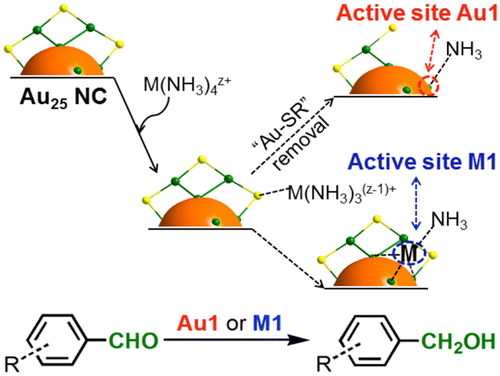当前位置:
X-MOL 学术
›
J. Am. Chem. Soc.
›
论文详情
Our official English website, www.x-mol.net, welcomes your
feedback! (Note: you will need to create a separate account there.)
Experimental and Mechanistic Understanding of Aldehyde Hydrogenation Using Au25Nanoclusters with Lewis Acids: Unique Sites for Catalytic Reactions
Journal of the American Chemical Society ( IF 14.4 ) Pub Date : 2015-11-06 , DOI: 10.1021/jacs.5b07716 Gao Li 1 , Hadi Abroshan 2 , Yuxiang Chen 2 , Rongchao Jin 2 , Hyung J. Kim 2, 3
Journal of the American Chemical Society ( IF 14.4 ) Pub Date : 2015-11-06 , DOI: 10.1021/jacs.5b07716 Gao Li 1 , Hadi Abroshan 2 , Yuxiang Chen 2 , Rongchao Jin 2 , Hyung J. Kim 2, 3
Affiliation

|
The catalytic activity of Au25(SR)18 nanoclusters (R = C2H4Ph) for the aldehyde hydrogenation reaction in the presence of a base, e.g., ammonia or pyridine, and transition-metal ions M(z+), such as Cu(+), Cu(2+), Ni(2+) and Co(2+), as a Lewis acid is studied. The addition of a Lewis acid is found to significantly promote the catalytic activity of Au25(SR)18/CeO2 in the hydrogenation of benzaldehyde and a number of its derivatives. Matrix-assisted laser desorption ionization (MALDI) and electrospray ionization (ESI) mass spectrometry in conjunction with UV-vis spectroscopy confirm the generation of new species, Au25-n(SR)18-n (n = 1-4), in the presence of a Lewis acid. The pathways for the speciation of Au24(SR)17 from its parent Au25(SR)18 nanocluster as well as its structure are investigated via the density functional theory (DFT) method. The adsorption of M(z+) onto a thiolate ligand "-SR-" of Au25(SR)18, followed by a stepwise detachment of "-SR-" and a gold atom bonded to "-SR-" (thus an "Au-SR" unit) is found to be the most likely mechanism for the Au24(SR)17 generation. This in turn exposes the Au13-core of Au24(SR)17 to reactants, providing an active site for the catalytic hydrogenation. DFT calculations indicate that M(z+) is also capable of adsorbing onto the Au13-core surface, producing a possible active metal site of a different kind to catalyze the aldehyde hydrogenation reaction. This study suggests, for the first time, that species with an open metal site like adducts [nanoparticle-M]((z-1)+) or fragments Au25-n(SR)18-n function as the catalysts rather than the intact Au25(SR)18.
中文翻译:

使用路易斯酸 Au25 纳米团簇进行醛加氢的实验和机理理解:催化反应的独特位点
Au25(SR)18 纳米团簇 (R = C2H4Ph) 在碱(例如氨或吡啶)和过渡金属离子 M(z+)(例如 Cu(+))存在下对醛加氢反应的催化活性,研究了作为路易斯酸的 Cu(2+)、Ni(2+) 和 Co(2+)。发现路易斯酸的加入显着提高了 Au25(SR)18/CeO2 在苯甲醛及其许多衍生物的氢化中的催化活性。基质辅助激光解吸电离 (MALDI) 和电喷雾电离 (ESI) 质谱联用紫外-可见光谱证实了新物种 Au25-n(SR)18-n (n = 1-4) 的产生。路易斯酸的存在。通过密度泛函理论 (DFT) 方法研究了从母体 Au25(SR)18 纳米团簇形成 Au24(SR)17 的途径及其结构。M(z+) 吸附到 Au25(SR)18 的硫醇盐配体“-SR-”上,然后逐步分离“-SR-”和与“-SR-”键合的金原子(因此是“Au -SR”单元)被认为是 Au24(SR)17 代最可能的机制。这反过来又将 Au24(SR)17 的 Au13 核暴露于反应物,为催化氢化提供活性位点。DFT 计算表明 M(z+) 也能够吸附到 Au13 核表面,产生不同种类的可能的活性金属位点来催化醛加氢反应。这项研究首次表明,具有开放金属位点的物种如加合物 [纳米粒子-M]((z-1)+) 或片段 Au25-n(SR)18-n 作为催化剂而不是完整的Au25(SR)18。并且发现与“-SR-”(因此是“Au-SR”单元)键合的金原子是最有可能产生 Au24(SR)17 的机制。这反过来又将 Au24(SR)17 的 Au13 核暴露于反应物,为催化氢化提供活性位点。DFT 计算表明 M(z+) 也能够吸附到 Au13 核表面,产生不同种类的可能的活性金属位点来催化醛加氢反应。这项研究首次表明,具有开放金属位点的物种,如加合物 [纳米粒子-M]((z-1)+) 或片段 Au25-n(SR)18-n 作为催化剂而不是完整的Au25(SR)18。并且发现与“-SR-”(因此是“Au-SR”单元)键合的金原子是最有可能产生 Au24(SR)17 的机制。这反过来又将 Au24(SR)17 的 Au13 核暴露于反应物,为催化氢化提供活性位点。DFT 计算表明 M(z+) 也能够吸附到 Au13 核表面,产生不同种类的可能的活性金属位点来催化醛加氢反应。这项研究首次表明,具有开放金属位点的物种如加合物 [纳米粒子-M]((z-1)+) 或片段 Au25-n(SR)18-n 作为催化剂而不是完整的Au25(SR)18。为催化加氢提供活性位点。DFT 计算表明 M(z+) 也能够吸附到 Au13 核表面,产生不同种类的可能的活性金属位点来催化醛加氢反应。这项研究首次表明,具有开放金属位点的物种如加合物 [纳米粒子-M]((z-1)+) 或片段 Au25-n(SR)18-n 作为催化剂而不是完整的Au25(SR)18。为催化加氢提供活性位点。DFT 计算表明 M(z+) 也能够吸附到 Au13 核表面,产生不同种类的可能的活性金属位点来催化醛加氢反应。这项研究首次表明,具有开放金属位点的物种如加合物 [纳米粒子-M]((z-1)+) 或片段 Au25-n(SR)18-n 作为催化剂而不是完整的Au25(SR)18。
更新日期:2015-11-06
中文翻译:

使用路易斯酸 Au25 纳米团簇进行醛加氢的实验和机理理解:催化反应的独特位点
Au25(SR)18 纳米团簇 (R = C2H4Ph) 在碱(例如氨或吡啶)和过渡金属离子 M(z+)(例如 Cu(+))存在下对醛加氢反应的催化活性,研究了作为路易斯酸的 Cu(2+)、Ni(2+) 和 Co(2+)。发现路易斯酸的加入显着提高了 Au25(SR)18/CeO2 在苯甲醛及其许多衍生物的氢化中的催化活性。基质辅助激光解吸电离 (MALDI) 和电喷雾电离 (ESI) 质谱联用紫外-可见光谱证实了新物种 Au25-n(SR)18-n (n = 1-4) 的产生。路易斯酸的存在。通过密度泛函理论 (DFT) 方法研究了从母体 Au25(SR)18 纳米团簇形成 Au24(SR)17 的途径及其结构。M(z+) 吸附到 Au25(SR)18 的硫醇盐配体“-SR-”上,然后逐步分离“-SR-”和与“-SR-”键合的金原子(因此是“Au -SR”单元)被认为是 Au24(SR)17 代最可能的机制。这反过来又将 Au24(SR)17 的 Au13 核暴露于反应物,为催化氢化提供活性位点。DFT 计算表明 M(z+) 也能够吸附到 Au13 核表面,产生不同种类的可能的活性金属位点来催化醛加氢反应。这项研究首次表明,具有开放金属位点的物种如加合物 [纳米粒子-M]((z-1)+) 或片段 Au25-n(SR)18-n 作为催化剂而不是完整的Au25(SR)18。并且发现与“-SR-”(因此是“Au-SR”单元)键合的金原子是最有可能产生 Au24(SR)17 的机制。这反过来又将 Au24(SR)17 的 Au13 核暴露于反应物,为催化氢化提供活性位点。DFT 计算表明 M(z+) 也能够吸附到 Au13 核表面,产生不同种类的可能的活性金属位点来催化醛加氢反应。这项研究首次表明,具有开放金属位点的物种,如加合物 [纳米粒子-M]((z-1)+) 或片段 Au25-n(SR)18-n 作为催化剂而不是完整的Au25(SR)18。并且发现与“-SR-”(因此是“Au-SR”单元)键合的金原子是最有可能产生 Au24(SR)17 的机制。这反过来又将 Au24(SR)17 的 Au13 核暴露于反应物,为催化氢化提供活性位点。DFT 计算表明 M(z+) 也能够吸附到 Au13 核表面,产生不同种类的可能的活性金属位点来催化醛加氢反应。这项研究首次表明,具有开放金属位点的物种如加合物 [纳米粒子-M]((z-1)+) 或片段 Au25-n(SR)18-n 作为催化剂而不是完整的Au25(SR)18。为催化加氢提供活性位点。DFT 计算表明 M(z+) 也能够吸附到 Au13 核表面,产生不同种类的可能的活性金属位点来催化醛加氢反应。这项研究首次表明,具有开放金属位点的物种如加合物 [纳米粒子-M]((z-1)+) 或片段 Au25-n(SR)18-n 作为催化剂而不是完整的Au25(SR)18。为催化加氢提供活性位点。DFT 计算表明 M(z+) 也能够吸附到 Au13 核表面,产生不同种类的可能的活性金属位点来催化醛加氢反应。这项研究首次表明,具有开放金属位点的物种如加合物 [纳米粒子-M]((z-1)+) 或片段 Au25-n(SR)18-n 作为催化剂而不是完整的Au25(SR)18。


















































 京公网安备 11010802027423号
京公网安备 11010802027423号